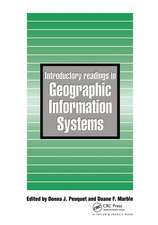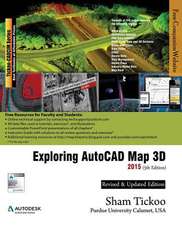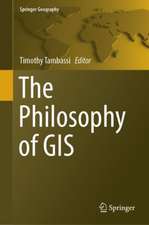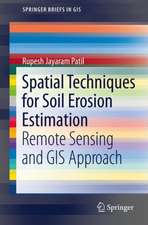Quo Vadis: Evolution of Modern Navigation: The Rise of Quantum Techniques
Autor F. G. Majoren Limba Engleză Hardback – 17 oct 2013
Intended for non-specialists with some knowledge of physics or engineering at the college level, this book covers in an intuitive manner a broad range of topics relevant to the evolution of surface and space navigation, with minimum mathematical formalism.
| Toate formatele și edițiile | Preț | Express |
|---|---|---|
| Paperback (1) | 951.29 lei 6-8 săpt. | |
| Springer – 23 aug 2016 | 951.29 lei 6-8 săpt. | |
| Hardback (1) | 963.91 lei 6-8 săpt. | |
| Springer – 17 oct 2013 | 963.91 lei 6-8 săpt. |
Preț: 963.91 lei
Preț vechi: 1175.51 lei
-18% Nou
Puncte Express: 1446
Preț estimativ în valută:
184.45€ • 193.22$ • 152.86£
184.45€ • 193.22$ • 152.86£
Carte tipărită la comandă
Livrare economică 08-22 aprilie
Preluare comenzi: 021 569.72.76
Specificații
ISBN-13: 9781461486718
ISBN-10: 1461486718
Pagini: 400
Ilustrații: XI, 426 p. 169 illus., 2 illus. in color.
Dimensiuni: 155 x 235 x 25 mm
Greutate: 0.98 kg
Ediția:2014
Editura: Springer
Colecția Springer
Locul publicării:New York, NY, United States
ISBN-10: 1461486718
Pagini: 400
Ilustrații: XI, 426 p. 169 illus., 2 illus. in color.
Dimensiuni: 155 x 235 x 25 mm
Greutate: 0.98 kg
Ediția:2014
Editura: Springer
Colecția Springer
Locul publicării:New York, NY, United States
Public țintă
Professional/practitionerCuprins
1. Navigation in Nature.- 2. The Early Navigators.- 3. Historical Background to Astronomy.- 4. Modern Astronomy.- 5. Navigation at Sea.- 6. The Longitude Problem.- 7. The Quartz Revolution.- 8. Classical Atomic Frequency Standards.- 9. Atomic and Molecular Oscillators.- 10. Field Confinement of Ions.- 11. Optical Frequency Oscillators: Lasers.- 12. The Gyrocompass.- 13. Radio Navigation.- 14. Satellite Navigation: GPS Space Segment.- 15. Satellite Navigation: GPS Control Segment.- 16. Satellite Navigation: GPS User Segment.- 17. Space Navigation.- 18. The Future of Navigation.
Recenzii
From the reviews:
“The book documents well the tremendous advances in navigation from the time of the Phoenicians and provides a good review of how navigation has evolved in nature … and in human exploration. Major explains the workings of the instrumentation that scientists and engineers invented for this purpose. … The book contains good references and illustrations … . Summing Up: Recommended. General readers and undergraduate students.” (N. Sadanand, Choice, Vol. 51 (9), May, 2014)
“The book documents well the tremendous advances in navigation from the time of the Phoenicians and provides a good review of how navigation has evolved in nature … and in human exploration. Major explains the workings of the instrumentation that scientists and engineers invented for this purpose. … The book contains good references and illustrations … . Summing Up: Recommended. General readers and undergraduate students.” (N. Sadanand, Choice, Vol. 51 (9), May, 2014)
Notă biografică
Dr Fouad Major was a student of Hans Georg Dehmelt, Nobel Prize winner (with Ramsey) in 1989, and was the first physicist to proves experimentally the capability of an atomic clock with ions stocked in a radio-electric quadripolar trap. He is an expert on atomic clocks and author of The Quantum Beat (Springer, 2007).
Textul de pe ultima copertă
Quo Vadis: Evolution of Modern Navigation presents an intelligent and intelligible account of the essential principles underlying the design of satellite navigational systems—with introductory chapters placing them in context with the early development of navigational methods. The material is organized roughly as follows: the first third of the book deals with navigation in the natural world, the early history of navigation, navigating by the stars, precise mechanical chronometers for the determination of longitude at sea, and the development of precise quartz controlled clocks. Then, the reader is introduced to quantum ideas as a lead in to a discussion of microwave and optical interactions with atoms, atomic clocks, laser gyrocompasses, and time based navigation. The final third of the book deals with satellite-based systems, including orbit theory, early satellite navigation systems, and a detailed treatment of the Global Positioning System (GPS).
Intended for non-specialists with some knowledge of physics or engineering at the college level, this book covers in an intuitive manner a broad range of topics relevant to the evolution of surface and space navigation, with minimum mathematical formalism.
Intended for non-specialists with some knowledge of physics or engineering at the college level, this book covers in an intuitive manner a broad range of topics relevant to the evolution of surface and space navigation, with minimum mathematical formalism.
Caracteristici
Provides a broad range of topics relevant to navigation and geographic position-finding, in an intuitive manner with minimum mathematical formalism Presents the progress of navigation throughout history, which enhances the understanding of the main technical challenges to be solved going forward Inclusive of extensive GPS technology coverage including receivers and applications




















